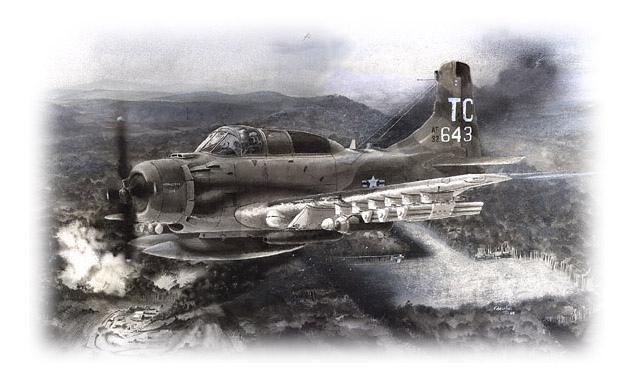 |
Minnesota Fats
|
| |
Blood, Sweat, and Tears
|
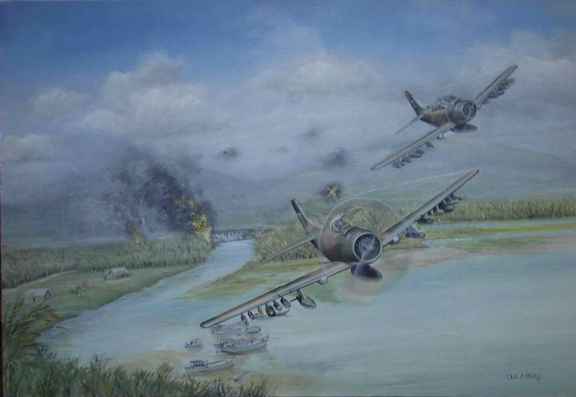 |
Over 1000 Skyraiders saw service in and around Viet-Nam with the US Navy, USAF and VNAF; the most famous use perhaps being that of the fire power provider during Search & Rescue, or "Sandy" missions. Depicted here are 2 Skyraiders, the single seat A-1H and the multi seat "Fat Face" A-1E on such a mission. Due to anti-aircraft activity, Fat face is forced to cross behind his single seat partner after a succesfull strike. Somewhere out there is a downed crew member, probably out on the left-hand side, as enemy vehicles cross the bridge in that direction. This painting brought a massive response from the A-1 veterans during the production of the painting, and I am very grateful to each and every one that took time to write. I hope as the finish approaches that you consider the painting a suitable tribute to all Sandy`s, especially those that gave their all. Please take time out to visit the Skyraider site, listen to the combat recordings found there, they are the most haunting sounds I have ever heard.
Global Aviation Art |
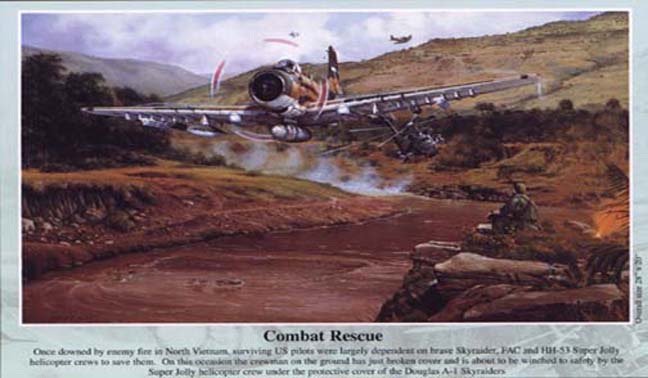 |
|
Once downed by enemy fire in North Vietnam, surviving US pilots were largely dependent on brave Skyraider, FAC and HH-53 Super Jolly helicopter crews to save them. Missions like this one in North Vietnam were always very dangerous, resulting in the loss of many rescue aircraft and their courageous crews. On this occasion the crewman on the ground has just broken cover and is about to be winched to safety by the Super Jolly helicopter crew under the protective cover of the Douglas A-1 Skyraiders - otherwise known by their call sign 'Sandy.' Keeping watch above is the Bronco spotter plane that first located the pilot on the ground, and then scoured the area ensuring there was no enemy threat to the rescue team.
Copyright © 2000 |
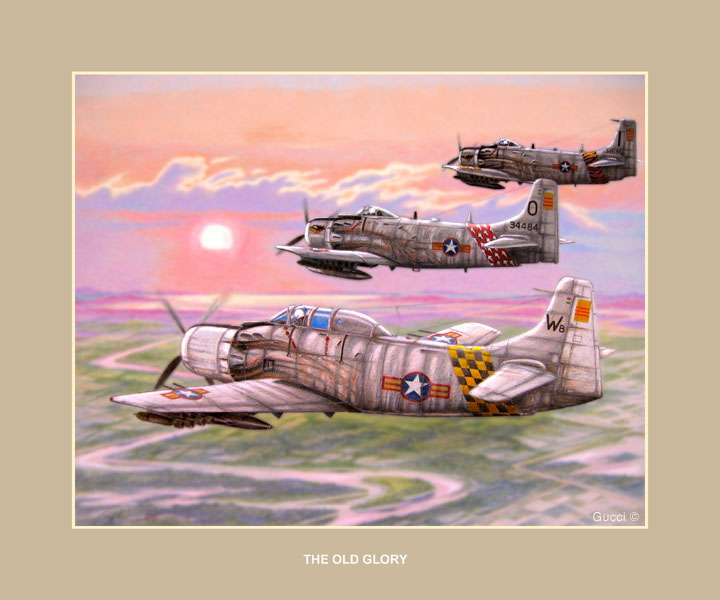 |
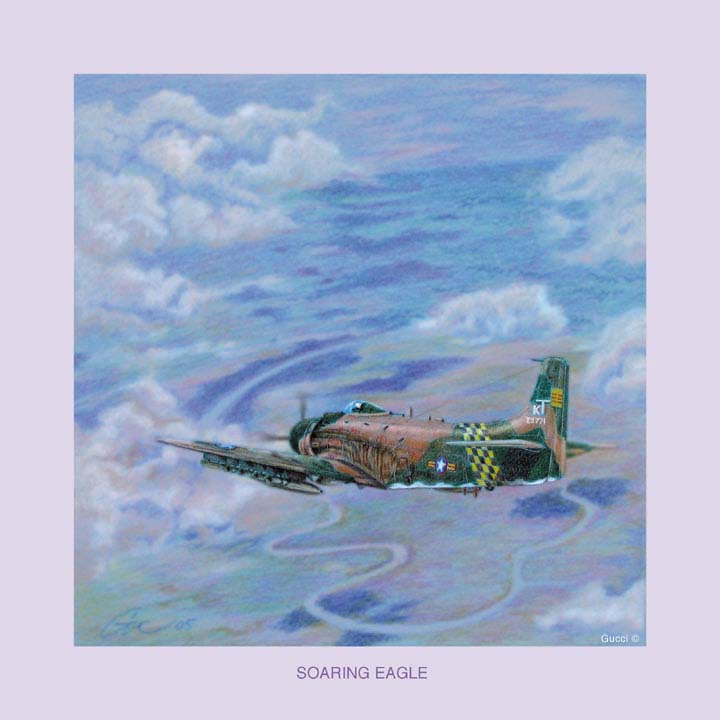 |
|
"The Old Glory" depicts the AD-5 and the AD-6 Skyraiders of the 1st VNAF Fighter Squadron (circa 1962) and "Soaring Eagle" shows off a lone A-1H in South East Asia camouflage scheme (SEA camouflage colors used in late stage of Vietnam war). A-1H Skyraiders are the "classic" propeller aircraft of South Vietnam Air Force, famous for its versatility and effectiveness in close air support during the Vietnam war. At that time when electronic gadgets, computer devices, smart bombs and laser-guide bombs didn't exist; then human skills, courage and determination were the main factors for the Skyraider pilots to carry out their missions successfully. There are numerous legends about the Vietnam era Skyraiders, but to sum up one can say: The Skyraider pilots never drop bombs, they just delivered the "packages" right on the Vietcong's address! For example, Lt. Tran The Vinh, a "tank killer" of VNAF 518 FS, with 8 bombs under the wings, he knocked out 6 T-54's. In the morning of April 9,1972, after scoring a total of 21 VietCong T-54's, He and his skyraider had gone forever over the sky of Quang Tri province. The A-1H Skyraiders served dutifully throughout the Vietnam war to the bitter end. In the morning of April 29, 1975, a Skyraider (serial #137588, commanded by Maj. Truong Phung) had been shot down by a Soviet Strela missile while defending Tan Son Nhut Air Base. Today, Skyraiders have ceased flying combat, a few retires in the aviation museums, but its magnificent images live on forever in the memories of many, who once witnessed the bravery of the unsung heroes over the freedom sky of South Vietnam. T.Pham
Copyright © 2005
|
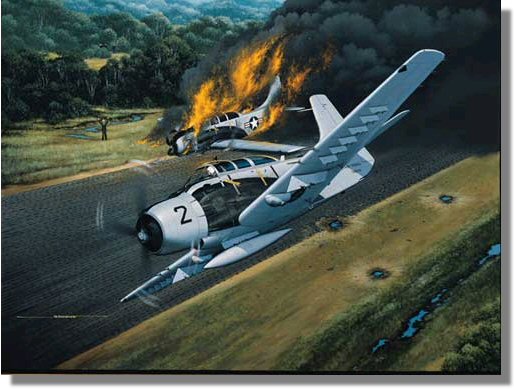 |
Situation: Major Bernard Fisher is depicted in Stan Stokes' painting during a mission in the A Shau Valley on March 10, 1966. A US Special Forces camp had faced several days of heavy attack by a large force of North Vietnamese troops, who had brought in ack-ack guns in anticipation of Air Force support. The monsoon season was still underway, and the North Vietnamese knew that this would also hinder American air support. Jet aircraft were of little use due to the low ceilings, and an AC-47 gunship and helicopter had both been downed while making low passes. A1-E Skyraiders from the 1st Air Commando Squadron at Pleiku were scrambled to support the Special Forces. During the second day in support of the A Shau battle, one Skyraider, piloted by Col. Dafford "Jump" Myers, was severely damaged, and in flames. The only alternative was an emergency landing on the airstrip in the lower-valley camp. Fisher, guided the stricken aircraft in for a belly landing. Failing to jettison his 300 gallon drop tank, Myer's Skyraider landed in a ball of flame as it skidded down the make shift runway. Myers successfully escaped the burning wreckage, but was within yards of enemy ground forces. Fisher and several other Skyraiders made several low passes laying down strafing fire and dropping ordnance. With any chance of helicopter rescue many minutes away, Major Fisher took matters into his own hands and landed his own aircraft on the damaged and refuse-laden landing strip, successfully rescuing his downed comrade. Fisher's Skyraider received 19 bullet holes, and for his heroic efforts Major Fisher became the first USAF officer to receive the Medal of Honor in Southeast Asia. Colonel Fisher now resides in Idaho. |